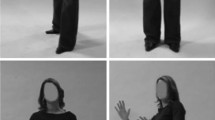Abstract
Few attempts have been made since the pioneer work of Ekman et al. (1980) to examine the development of the deliberate control of facial action units in children. We are reporting here two studies concerned with this issue. In Study 1, we investigated children’s ability to activate facial action units involved in sadness and happiness expressions as well as combinations of these action units. In Study 2, we examined children’s ability to pose happiness and sadness with their face, without telling them which action unit to activate. The children who took part in this study were simply asked to portray happiness and sadness as convincingly as possible. The results of Study 1 indicate a strong developmental progression in children’s ability to produce elementary facial components of both emotions as well as in their ability to produce a combination of the elements in the case of happiness. In agreement with prior research in motor development, several non-target action units were also activated when children performed the task. Their occurrence persisted throughout childhood, indicating limitations in the finer motor control achieved by children across age. The results obtained in Study 2 paralleled those obtained in Study 1 in many respects, providing evidence that the children used the technique of deliberate action to pose the two target emotions.





Similar content being viewed by others
Notes
The coactivation of the cheek raiser was not an artifact due to the coding of the material, as we used the 1992 FACS version. This version contains norms for coding the presence of the cheek raiser when the lip corner puller is activated at high intensity (levels D and E).
Although the task performed by the participants in Gosselin et al.’s (2010) study was very similar to that used in Study 1, performance was not assessed exactly in the same way. In order to meet the specificity criterion, the target action unit had to be activated without any non-target action units during the complete duration of a given trial. In the present study, we considered the specificity criterion was met if the target action unit was activated without any non-target action units at some point during a given trial, as Ekman et al. (1980) did. This difference in assessing performance explains why, for some action units, the children in this study did somewhat better than the adults who participated in Gosselin et al.’s study.
References
Cacioppo, J. T., Petty, R. E., Losh, M. E., & Kim, H. S. (1986). Electromyographic activity over facial muscle regions can differentiate the valence and intensity of affective reactions. Journal of Personality and Social Psychology, 50, 260–268.
Darwin, C. (1872). The Expression of the Emotions in Man and Animal. London, UK: John Murray.
Duchenne de Boulogne, G. B. (1862). Mécanisme de la physiologie humaine ou analyse électrophysiologique de l’expression des passions. [The mechanism of human facial expression or an electrophysiological analysis of the expression of the emotions.] Paris: Baillière (A. Cuthertson, Trans. 1990, New York: Cambridge University Press).
Ekman, P. (2003). Emotions revealed: Recognizing faces and feelings to improve communication and emotional life. New York: Times Books.
Ekman, P., & Friesen, W. V. (1978). Facial Action Coding System (FACS): A technique for the measurement of facial action. Palo Alto: Consulting Psychologists Press.
Ekman, P., & Friesen, W. V. (1982). Felt, false, and miserable smiles. Journal of Nonverbal Behavior, 6, 238–252.
Ekman, P., & Friesen, W. V. (1992). FACS update document. Unpublished manuscript.
Ekman, P., Roper, G., & Hager, J. C. (1980). Deliberate facial movement. Child Development, 51, 886–891.
Gosselin, P., Kirouac, G., & Doré, F. Y. (1995). Components and recognition of facial expression in the communication of emotion by actors. Journal of Personality and Social Psychology, 68, 83–96.
Gosselin, P., Perron, M., & Beaupré, M. (2010). The voluntary control of facial action units in adults. Emotion, 10, 266–271.
Green, J. R., Moore, C. A., Higashikawa, M., & Steeve, R. W. (2000). The physiologic development of speech motor control: Lip and jaw coordination. Journal of Speech, Language, and Hearing Research, 43, 239–255.
Gross, L., & Ballif, B. (1991). Children’s understanding of emotion from facial expressions and situations: A review. Developmental Review, 11, 368–398.
Kwint, L. (1934). Ontogeny of mobility of the face. Child Development, 5, 1–12.
Lewis, M., Sullivan, M. W., & Vasen, A. (1987). Making faces: Age and emotion differences in the posing of emotional expressions. Developmental Psychology, 23, 690–697.
Odom, R. D., & Lemond, C. M. (1972). Developmental differences in the perception and production of facial expression. Child Development, 43, 359–369.
Provins, K. A. (1997). The specificity of motor skill and manual asymmetry: A review of the evidence and its implications. Journal of Motor Behavior, 29, 183–192.
Rinn, W. E. (1984). The neuropsychology of facial expressions: A review of the neurological and psychological mechanisms for producing facial expressions. Psychological Bulletin, 95, 52–77.
Rosenberg, E. L., & Ekman, P. (2005). Coherence between expressive and experiential systems in emotion. In P. Ekman & E. L. Rosenberg (Eds.), What the face reveals (pp. 63–85). New York: Oxford University Press.
Scherer, K. R., & Ellgring, H. (2007). Are facial expressions of emotion produced by categorical affect programs or dynamically driven by appraisal? Emotion, 7, 113–130.
Schwartz, G. E., Fair, P. L., Salt, P., Mandel, M. K., & Klerman, G. L. (1976). Muscle patterning to affective imagery in depressed and non-depressed subjects. Science, 192, 489–491.
Widen, S. C., & Russell, J. A. (2008). Children acquire emotion categories gradually. Cognitive Development, 23, 291–312.
Author information
Authors and Affiliations
Corresponding author
Rights and permissions
About this article
Cite this article
Gosselin, P., Maassarani, R., Younger, A. et al. Children’s Deliberate Control of Facial Action Units Involved in Sad and Happy Expressions. J Nonverbal Behav 35, 225–242 (2011). https://doi.org/10.1007/s10919-011-0110-9
Published:
Issue Date:
DOI: https://doi.org/10.1007/s10919-011-0110-9




